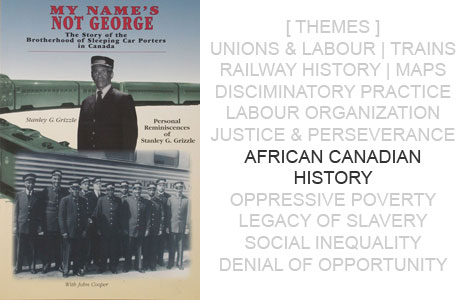Careers: Discovering the Workplace
Level: Grade 10 Open
Purpose:
This lesson's purpose is to understand the history of the struggle of the Sleeping Car Porters for fair wages and working conditions, and the role of the Union in their success. Further, the purpose is to illuminate the many ways in which working conditions have improved, better to protect workers' health, safety and to become familiar with the legal protections that protect this improvement.
Strand:
Understanding the Workplace
Learning Objectives:
- Become familiar with working conditions of Sleeping Car Porters prior to unionization, and to workplace legislation.
- Connect with community resources and family members to explore present day working conditions;
- Become familiar with relevant legislation;
- Learn of the history and importance of unions and union organizing.
Materials:
My Name's Not George: The Story of the Brotherhood of Sleeping Car Porters in Canada. Toronto: Umbrella Press, 1997.
As suitable: Canada Labour Code, Employment Standards Act, Hazardous Products Act, Ontario Human Rights Act,
Family members, working friends, or school staff.
Prior Knowledge:
Prior knowledge of civil rights and workers' struggles in Canada and the United States would be an asset. Teachers should read My Name's Not George in its entirety before proceeding with this lesson. Teacher should also have workplace legislation up in the classroom and accessible for classroom conversations.
Activity:
Day 1
Read Chapters 1-8. Analyse the working conditions endured by Grizzle and his fellow workers.
Discuss: what would you do faced with these conditions? what did they do?
Together as a class brainstorm the characteristics of poor working conditions, generating a list on the board. If students have had jobs, they might contribute their own experiences to the discussion.
Broken up into small groups (2 or 3), students chose two people to interview about workplace conditions, and brainstorm a list of questions to ask.
The whole group discusses the questions generated and picks no more than ten.
As homework, students interview a family member or friend regarding their working conditions.
Day 2
Students report on their interviews, assessing what they consider the good and bad working conditions they have discovered from their interviews and/or experience. They begin familiarizing themselves with the existing legislation covering the employment they have encountered in the interviews.
Day 3
Group presentations consolidate their assessments of particular workplace situations, and any legislation that might apply.
Extension:
Return to your interviewee with documentation of legislation that addresses specific undesirable workplace conditions, and helps to identify where and how the interviewee might seek assistance.

